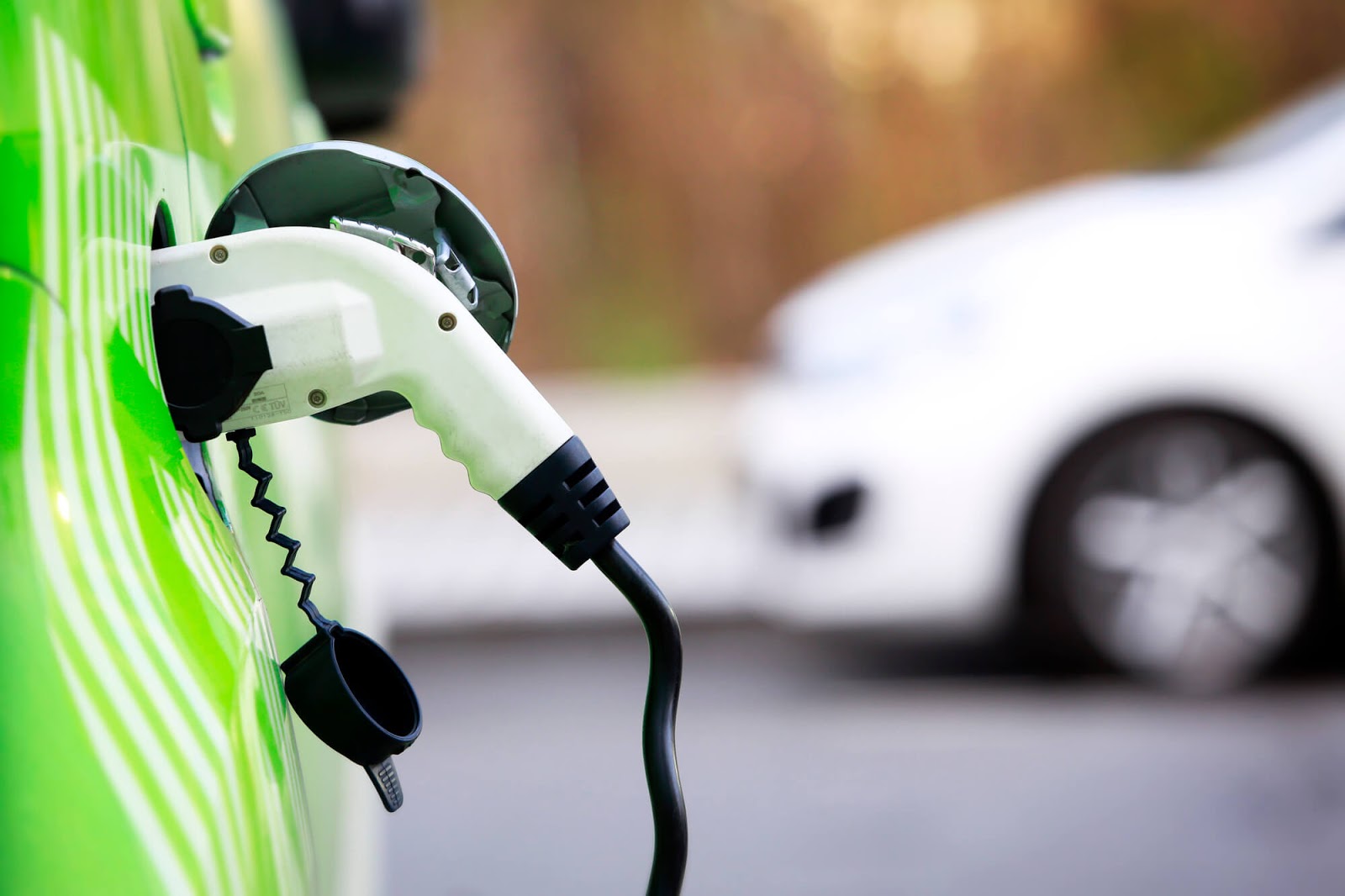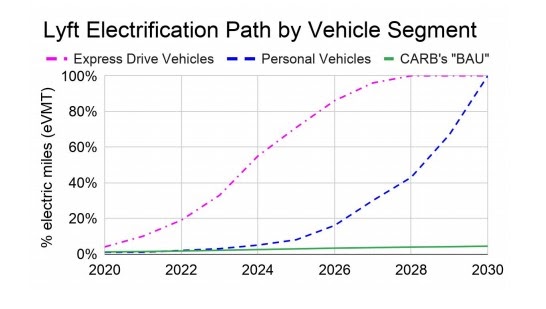👉 Do you use an EV to drive for rideshare or delivery? Join our Facebook Group for EV gig drivers for discussions about the current state and future of EVs.
Updated July 2020: Looks like Lyft got a head start on this announcement – now it might be required by the state of California!
Wired recently covered an announcement that California’s Air Resources Board (CARB) had recently submitted a proposal that would push for Lyft and Uber to go electric. The proposal is asking for 60% of miles traveled by Lyft and Uber drivers be in electric vehicles by 2030. This goes along nicely with Lyft’s goal of going 100% electric on the same timeline.
Uber does not appear to be setting goals or putting similar plans into place.
Drivers might be concerned about being forced into buying electric, but Lyft has plans for a transition that includes having only EVs available through their Express Drive program (continue reading below).
Overall, 60% seems more feasible at this point than 100% because it would allow some drivers to continue driving with their current vehicles, allowing them to decide to transition or not. It would be good to know if Lyft would allow for hybrid vehicles to help alleviate worries drivers may have about being stranded in the middle of nowhere if their EV runs out of juice.
Original article: On Wednesday, Lyft announced an ambitious goal: by 2030, Lyft will transition to 100% electric vehicles. This means all Express Drive vehicles, their consumer rental car program, autonomous vehicles – and yes, drivers’ personal cars.
It’s a big goal – with a big caveat. Lyft isn’t making the switch to EVs a requirement for drivers.
Lyft is hoping you switch and will work to provide incentives to do so, but if you’re worried about ‘having’ to buy an electric vehicle, don’t be!
Below, we’ll cover how Lyft plans to roll this out and how they plan on encouraging drivers to make this transition.
Related articles:
- The 5 Best Electric Vehicles for Uber and Lyft Drivers
- What It’s Like Driving a Chevy Bolt EV for Uber and Lyft
- Driving for Uber with a Tesla Model 3

Why is Lyft Turning to Electric Vehicles (EVs) For Their Entire Platform?
You can watch our full video covering this news here and below: Lyft Announces 2030 Goal of Transitioning Platform to Electric Vehicles (Is this bad for drivers?)
Lyft transitioning to electric vehicles shouldn’t be too surprising to those of you following the news – climate change is happening, and transportation recently overtook electricity as the single largest source of planet-disrupting greenhouse gas pollution in the US.
In order to make a dent on what is happening to our planet, Lyft has decided to make the bold goal to go entirely green – at least in terms of vehicle emissions.
In their announcement, Lyft announced they are working in collaboration with the Environmental Defense Fund in their transition and commitment to reaching 100% electric vehicles on the Lyft platform by 2030.
Lyft has outlined three steps to get to fully EV on their platform by 2030:
- Focusing on policies to achieve EV cost-parity (with gasoline powered vehicles)
- Lead with Express Drive EV rentals to provide nearer-term EV access
- Build demand for EVs among millions of Lyft platform users, including drivers and passengers
Drivers (Eventual) Switch to Electric Vehicles
Right now, Lyft has given their platform (including drivers) ten years to make the transition to electric vehicles (EVs).
However, when we reached out to Lyft about requiring drivers to switch to EVs, they told us that drivers will not be required to switch to EVs. Instead, a Lyft spokesperson said, “we believe we can help make driving an EV a preferable choice and are committed to helping drivers transition to these types of cars over time.”
Lyft understands that drivers will need more time than other parts of their platform, like Express Drive. Take a look at the chart below – Lyft shows that driver adoption of EVs will be slower than Express Drive adoption:

One way Lyft expects drivers to be able to achieve going fully electric by 2030 is the cost of electric vehicles to continue to decrease, via cost-effective battery technology and policy support for vehicle purchasing and charging. Lyft specifically says they expect drivers to ‘significantly ramp up adoption of EVs by 2026.’
Driving an Electric Vehicle
Lyft’s statement on electric vehicles, particularly acknowledging how EVs cost more upfront than gas-powered cars, is really the crux of the matter for drivers. Should drivers (eventually) switch entirely to electric vehicles?
Unless you were explicitly planning on buying an electric vehicle in the future (and built that into your budget), you’re probably like most drivers and are looking for the most efficient, affordable, and dependable ride.
Here at The Rideshare Guy, we have actually been fans of hybrids (and more recently, EVs) for years. In fact, we found that a 2011 Toyota Prius is your best, most economical choice as a driver (in our 2018 article ‘Is the Toyota Prius the Best Car for Uber & Lyft Drivers?’).
Since then, the EV options have gotten better and better, and in our latest article on EVs, we came down in favor of the Chevy Bolt EV as the new ‘best EV for rideshare drivers’.
You can see our full review of what it’s like driving for rideshare with a Chevy Bolt EV – check it out to see if the Chevy Bolt EV is a good option for you.
We even put together a spreadsheet to determine the best EV and vehicle options for drivers.
Putting all this data together yielded some surprises. The first is that thanks to the cheap price of gas, for most places in the United States, a good used hybrid will be the most economical way to drive.

However, prices continue to decrease for electric vehicles. In our article last year, RSG contributor Gabe Ets-Hokin noted (updated),
“I’m seeing [Chevy Bolt EVs] with fewer than 40,000 miles on Autotrader for under $17,000, but additionally GM dealers are offering as much as $8,500 in cash back on a new one! Combined with state and local incentives as well as dealer discounts (sadly, the Federal tax credit expired in March), you could steal a new Premier model for a net cost of under $25,000.”
In our article on the best electric vehicle options, we even found a super cheap option in the Nissan Leaf. As Gabe pointed out,
“If your Uber/Lyft style is lots of short trips (or you mainly do delivery) and you usually take a break during the day, you may have some success with a used Nissan Leaf.
The Leaf is the most prolific EV in North America, with 133,000 sold here since 2011. That means there are a lot of them on the used market: I saw over 1,000 results on a recent Autotrader.com search.
You can get a low-mile 2011 or 2012 for $3,800…
The way to go would be to find a clean, low-mile 2016 or newer model, with the 30 kWh battery. It’s a more-durable design and offers 110 miles of range.
You can find these for under $9,000, or splurge and get a 2018 or newer with the 40 kWh pack and 151 miles of range under $18,000, but the killer deal from Nissan right now is leftover new 2019 Leaf-Plus models, which offer 215 miles of range, massively discounted to under $22,500. That’s cheaper than the “Bluebook” value of a used one.”
There’s also the Tesla option, although chances are it’s out of most drivers’ price range – for now!
What This Means for Drivers
As great as this is for the environment, as cheap as it is to drive an electric vehicle, and as much as Lyft wants us drivers to go in this environmentally-friendly direction by 2030, what does this really mean for drivers?
One, drivers don’t have to buy an EV if they don’t want to. Lyft has said this will not be mandatory for drivers.
This isn’t surprising: how could Lyft force drivers to buy new electric vehicles when drivers aren’t employees in the first place? We’re only independent contractors – unless you live in California.
Two, what’s Lyft’s responsibility here to make it enticing for drivers to switch to EVs? Lyft has said they will, over the next decade, work with the Environmental Defense Fund, government agencies and industry partners to “implement policies and incentives that will help make EVs more affordable and make EV charging easier, cheaper and more reliable.”
They plan on informing drivers of EV tax incentives and rebates, work with automakers and charging partners for promotions and discounts, and help drivers switch over in a profitable way.
In the next ten years, getting rebates, tax incentives, discounts, and reliable access to charging stations is going to be key to mass adoption of EVs, but what will really make it happen is price and performance parity with internal-combustion engine (ICE) vehicles.
If prospective rideshare drivers can’t perform their jobs profitably and conveniently with an EV, they just won’t do it.
That means an EV must be able to drive enough miles in a shift without charging (or charging has to be almost as fast and convenient as a gas fillup), and the overall cost of operation must be the same as a similar ICE car as well.
Without that happening, Lyft’s requirement is lip service, no matter how much they claim to be “leaders in the fight against climate change.” To that end, Lyft says it will “[work] with policymakers and partners [to] drive down the cost of EVs, expand EV incentives and infrastructure, and help drivers switch to electric…” But the press release is light on specific details.
Except for one. “[W]e’re ending our carbon offsets program to allow us to focus our efforts on direct decarbonization through the switch to EVs. While this means net emissions from cars used on the Lyft platform may increase in the short term, shifting to 100% EVs will lead to dramatically lower emissions over the long term.”
We’re rideshare gurus, not math whizzes here at RSG, but we do know ‘100%’ means all of something, not half or even 99.9%. We don’t understand how Lyft will reach this goal without any concrete initiatives ensuring no greenhouse gas-producing vehicles will be used on the platform after 2030, and both Uber and Lyft are well known for resisting government regulations they don’t craft themselves. So will it happen?
Our guess is it will (mostly) happen, not because Lyft is the super-green, enviro-friendly company it claims to be, but because EVs have a good shot at becoming the more affordable and practical choice and there will be a glut of perfectly fine (and affordable) used models in the marketplace.
Readers, what do you think of this goal announcement from Lyft?
-The RSG Team with additional reporting from Gabe Ets-Hokin
Related articles:
- The 5 Best Electric Vehicles for Uber and Lyft Drivers
- What It’s Like Driving a Chevy Bolt EV for Uber and Lyft
- Driving for Uber with a Tesla Model 3
👉 Do you use an EV to drive for rideshare or delivery? Join our Facebook Group for EV gig drivers for discussions about the current state and future of EVs.




